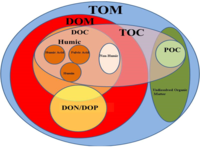
Photo from wikipedia
Abstract Ecosystem respiration (Reco) and its components, the autotrophic respiration (Ra) and soil respiration (Rs) are the essential indicators of the global carbon cycle. They are represented as functions of… Click to show full abstract
Abstract Ecosystem respiration (Reco) and its components, the autotrophic respiration (Ra) and soil respiration (Rs) are the essential indicators of the global carbon cycle. They are represented as functions of either temperature or soil moisture, or a combination of both in the widely-used Earth System Models (ESMs). Thus, it is difficult to evaluate the influence of other environmental factors (such as, precipitation, soil temperature, dissolved oxygen level and oxidation reduction potential (ORP)) on Ra, Rs and Reco. Here we introduced microbially mediated, detailed carbon cycle processes within our mechanistic model to address this issue. Dominance analysis using a multivariate approach was performed to find out the influence of individual environmental factors on Ra, Rs and Reco in the cold climate regions of Athabasca River Basin (ARB), Canada. Contribution of the 6 predictor variables, including air temperature, precipitation, soil temperature, water-filled pore space (WFPS) used as a proxy of soil moisture, dissolved oxygen level, and ORP, on Ra, Rs and Reco were estimated based on the R2 values originated from multiple regression analyses. Our results showed that the prevailing temperature (both air and soil) and dissolved oxygen levels are the major influencing factors on Ra, Rs and Reco. WFPS is found to be the least influential factor on respiration estimation. Output of this study can be used to consider the crucial roles of environmental drivers in Ra, Rs and Reco estimation in the development of future ESMs.
Journal Title: Ecological Indicators
Year Published: 2021
Link to full text (if available)
Share on Social Media: Sign Up to like & get
recommendations!